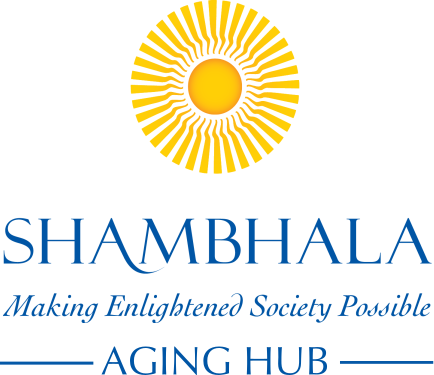By Ann Cason and CamilleYarbrough.
The AGING HUB (http://aging-hub.shambhala.org), a new project of the Shambhala Working Group on Aging, will be launched on December 17, 2016. It has been funded by the Shambhala Trust and by donations from the sangha. I hope and the Working Group on Aging and the Shambhala Trust all hope that this HUB will reflect the teachings without being too didactic and will spark discussion and contemplation and sanity as we ourselves age and care for loved ones or are cared for by those we love.
The goal of the Aging Hub is to provide information, education, and provoke discussion; and also to collect stories from centers around the world about the challenges of aging we face and about how we are meeting those challenges. Perhaps, over the next few years, we will know what the Warriorship of Aging is. How it is to age in enlightened society. Can we help?
In the late 1970s, Victoria Howard and I, who were leading Dana Home Care (a nonprofit that allowed older people to stay at home until they died), had a brochure designed with a picture of a chrysanthemum on it. The flower had delicate lines enfolded in leaves – an image of nurturance like wrapping a baby in a blanket. When we showed it to Trungpa Rinpoche, he said, “No. Like this.” He was sitting at his desk but he spread his arms out wide, opening to and enfolding a space without beginning or end; a space so vast that all perfections and imperfections could dance within it with lightness. I remember the shock of his vision that the frail old people, who seemed to need such nurturance, could abide in such a warm, aware and spacious way rather than creeping along until falling into the grave.
And then around the same time, on September 12, 1978, Rinpoche gave a talk to the vastly extended Dana Home Care staff, sitting on folding chairs in the basement of Dorje Dzong. He came in, sat down and simply told us, “Caring for old people is the work of warriors. Any questions?” A wonderful discussion took place – much like our present day salons in which situations and challenges present themselves, we discuss, listen, drop our desire for resolution, then go away uplifted. He gave us this amazing way to communicate about care. Not that there aren’t things to learn: how to enter; how to wipe a bottom and then keep it secret while you serve tea in good china cups; how to take the blame and keep a cheerful state of mind.
Now as an aging person, I am finding that the years of working with sick and aging people leave me well prepared to understand the aging process and to help our sangha look at aging. I also want to share the wisdom about aging that is coming to us from Sakyong Mipham Rinpoche. In his contemplative approach, the awareness of aging is not limited to what we are at old age but is part of the whole life stream. The Sakyong has created a weekend program called Rites of Passage for adults which he is encouraging us to do every 10 years starting at age 20 and going to 108. These are powerful trainings for our life transitions. We can also look at the curriculum for the Way of Shambhala which are teachings on how to live and age during our entire lifetime from the point of view of Basic Goodness and the four dignities. These teachings on how to find contentment, joy, fearlessness, and wisdom can be taken over and over until realization occurs. In particular, these classes help us develop our contemplative skills as well as to listen to and work on the development of community.
And finally, much of society’s work on aging and end-of-life has become a method or prescription for how to die like a saint and avoid being a sinner. Let’s go beyond either/or. What I like about the Sakyong’s nonjudgmental way is the emphasis on being human. We live and die as human beings and one thing we have trouble with is the slipping from the doing into the being of our lives. We don’t know how to be; we don’t feel our basic human nature and so we make up all kinds of stories about how good it could be to age and get old. So many concepts and judgments have stood in the way of trusting and appreciating what we feel. Our old minds wander and our sore bones crack. Looking to be good, we miss the enjoyment. And we sometimes miss the ways that we can help.
Let’s talk. Let’s share. Let’s discover for ourselves what it is to age in enlightened society.
And please, if you like what you see, share your thoughts and perhaps make a donation to help us go on with our Spring 2017 edition of the Hub which will be on Death and Dying.
Ann Cason and Camille Yarbrough
Co-chairs, Shambhala Working Group on Aging
Lifeboat at Aldeburgh, by Eric Ravilious. Public domain from wikiart.org

